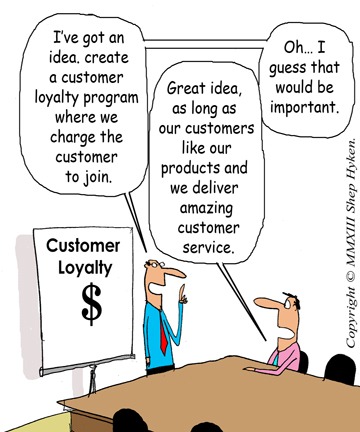 Loyal Customers
Loyal Customers
Companies covet customer loyalty. They understand the benefit to having loyal customers. Statistics show, over and over again, the financial advantages to customer loyalty, versus the continuous quest for new customers. So how do some companies achieve customer loyalty?
- The company creates a loyalty program that tracks their customers’ purchases and rewards customers for their repeat business. For example, airlines give their loyal passengers early boarding privileges, free upgrades and points toward free trips. Or a sandwich restaurant that gives the customer a free sandwich on their tenth visit.
- And, there are companies that build relationships and deliver a level of customer service that is so good that their customers wouldn’t consider going anywhere else. Personally, this is my favorite.
- Then there is a third way. The customer pays the company for the privilege of being a part of their loyalty program. What a concept! Seriously, this is powerful, if not interesting.
AMC Theatres loyalty program, called AMC Stubs, charges their customers $12 a year to be a member. That’s just $1 per month. What do customers get for that? AMC waives fees for online movie ticket purchases, credits the customer $10 for every $100 spent and gives free upgrades to larger popcorn and drinks. So, if you are the customer who paid to be part of the loyalty program, why would you waste your money and do business with any other movie theatre? Most people wouldn’t.
Then there is my favorite, the Amazon.com Prime program. Amazon actually refers to this as a membership program, but many of their customers, along with industry experts, consider this to be a loyalty program. For an annual fee of $79, the customer gets free two-day shipping, free movie streaming and Kindle book rentals. There’s no tracking about how much business the customer does with Amazon. The benefit is the same for the customer who buys one $10.00 book as for the customer who spends thousands of dollars on merchandise. So, how can this really be considered a loyalty program?
My take on it is that the customer spends enough money on the program that they will think twice before doing business with one of their competitors. The customer may even look for reasons to do business with Amazon, just to take advantage of the membership fee.
And, here may be the most important part. To get customers to pay this fee, Amazon has to do two things so well, that the customer views the $79 fee to be a bargain. First, they are amazing retailers and sell what customers want. Second, they deliver amazing customer service. That’s a winning combination.
So, here are two questions for you to consider:
Is your company so good that your customers would be willing to be loyal to you with or without the incentive of a loyalty program – or even be willing to pay to be a part of a loyalty program?
If the answer is “Yes,” you are in some amazing company.




It’s well to remember that there are some retailers, like Walmart and Publix, that believed low prices were their principal appeal, and never felt they needed a customer loyalty program. And there are others, like Albertson’s, Shaw’s, and Acme (three of the supermarket chains recently acquired by Cerberus Capital), which eliminated their loyalty programs
Hi Michael – Some companies confuse loyalty programs with marketing programs. True loyalty should exist, even if there isn’t a loyalty program. However, low price retailers will only have loyalty as long as nobody undercuts them. The best companies offer value – usually in the customer experience, but there are other ways to offer value as well.